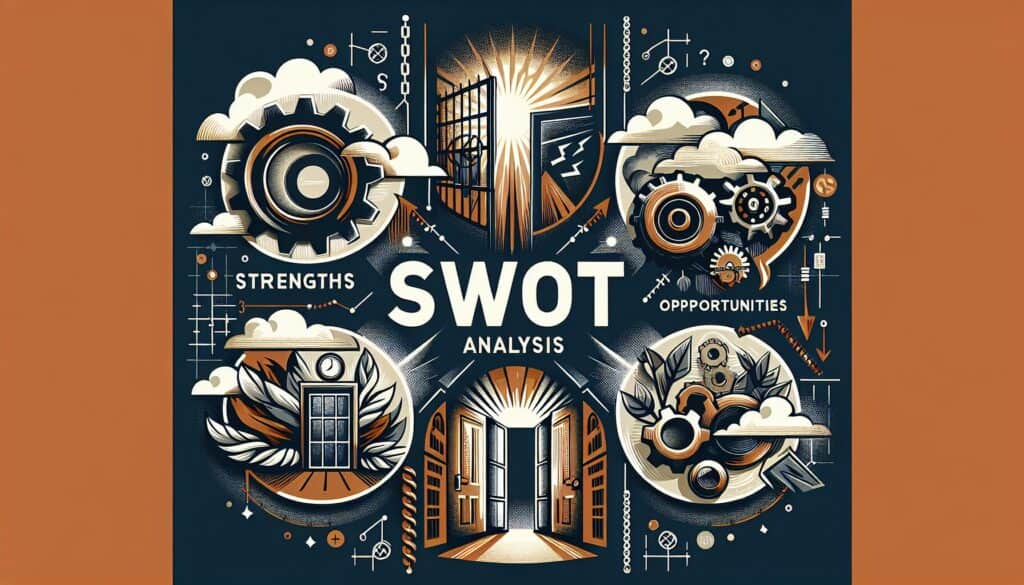To evaluate an organization’s, project’s, or individual’s Strengths, Weaknesses, Opportunities, and Threats to inform strategic planning.
- Methodologien: Kunden & Marketing, Ideenfindung, Produktdesign
SWOT-Analyse

SWOT-Analyse
- Geschäftsprozess-Reengineering (BPR), Wettbewerbsanalyse, Innovation, Marktforschung, Projektmanagement, Risikomanagement, SWOT, SWOT-Analyse
Zielsetzung:
Wie es verwendet wird:
- Strengths (internal, positive attributes), Weaknesses (internal, negative attributes), Opportunities (external, factors that can be exploited), and Threats (external, factors that could cause trouble) are identified and listed, often in a four-quadrant matrix.
Vorteile
- Einfacher Rahmen für die Organisation strategischen Denkens; Hilft bei der Identifizierung wichtiger interner und externer Faktoren; Erleichtert Diskussionen und Konsensbildung; Kann breit und auf verschiedenen Ebenen angewendet werden.
Nachteile
- Can be subjective and based on opinions rather than data; May generate long lists without clear prioritization; Does not inherently offer solutions or actions; Static and may quickly become outdated.
Kategorien:
- Kunden & Marketing, Wirtschaft, Ideenfindung, Projektmanagement
Am besten geeignet für:
- Strategic planning, business planning, competitor analysis, and assessing the viability of new initiatives.
SWOT Analysis finds extensive applicability across various sectors including technology, healthcare, manufacturing, and consumer services, often employed during the early stages of project development or strategic planning sessions to evaluate the potential of new product ideas or market entries. Teams made up of product designers, engineers, marketing professionals, and business strategists frequently initiate the SWOT process, allowing for diverse perspectives that can enrich the output of the analysis. In industries such as healthcare, for instance, this method is particularly useful when launching innovative medical devices where understanding both the internal capacities of the organization and the external demands of regulatory compliance and market needs is paramount. The simplicity of the matrix encourages brainstorming sessions that not only identify strengths and weaknesses but also stimulate discourse around how to leverage untapped opportunities—such as emerging technologies or shifting consumer preferences—and mitigate potential threats, including competitive pressures or economic downturns. Organizations can engage in SWOT Analysis at various levels, from a high-level assessment of company strategy to a focused analysis of specific products or initiatives, allowing for flexibility in its application. As a strategic planning tool, it promotes alignment among stakeholders, driving consensus on priorities and enabling teams to formulate actionable plans based on a structured evaluation of both internal capabilities and external market dynamics.
Die wichtigsten Schritte dieser Methodik
- Identify and list internal strengths relevant to the product or initiative.
- Identify and list internal weaknesses that could hinder progress.
- Identify and list external opportunities that can be leveraged.
- Identify and list external threats that could pose risks.
- Analyze the relationships between internal strengths and external opportunities.
- Evaluate how internal weaknesses can be mitigated by addressing external threats.
- Develop strategic initiatives based on the analysis of the SWOT matrix.
Profi-Tipps
- Integrate quantitative data analysis with qualitative observations to enhance the reliability of the SWOT findings.
- Regularly update the SWOT matrix to reflect changes in the market landscape and internal capabilities, fostering agility in strategic responses.
- Involve cross-functional teams in the SWOT analysis process to uncover diverse perspectives and reduce blind spots in assessment.
Verschiedene Methoden lesen und vergleichen, Wir empfehlen die
> Umfassendes Methoden-Repository <
zusammen mit den über 400 anderen Methoden.
Ihre Kommentare zu dieser Methodik oder zusätzliche Informationen sind willkommen auf der Kommentarbereich unten ↓ , sowie alle ingenieursbezogenen Ideen oder Links.
Historischer Kontext
1960
1980
1983
1990
1995
2000
2010
1950
1980
1980
1986
1994
1995
2000
(wenn das Datum nicht bekannt oder nicht relevant ist, z. B. "Strömungsmechanik", wird eine gerundete Schätzung des bemerkenswerten Erscheinens angegeben)














Verwandte Artikel
METS-Kalorien-Rechner
Meta-Analyse
Nachrichten-Mapping
Mentalmodell-Diagramme
Maximal zulässige Druck- und Zugkräfte
Materialbedarfsplanung (MRP)